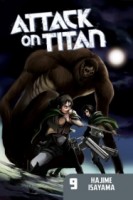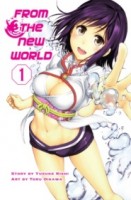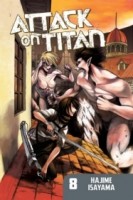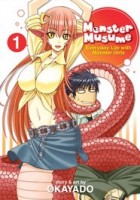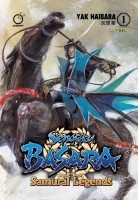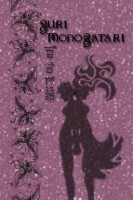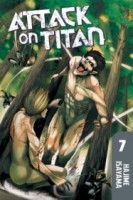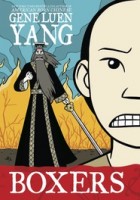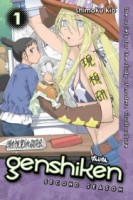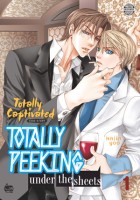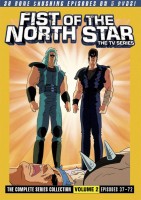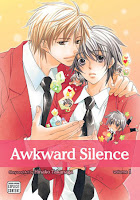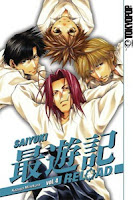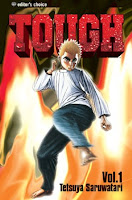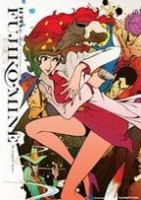My News and Reviews
Two reviews were posted last week at Experiments in Manga. The first review was for Yaya Sakuragi’s boys’ love manga Bond of Dreams, Bond of Love, Volume 3. Although the series isn’t my favorite work by Sakuragi, I tend to enjoy her manga and Bond of Dreams, Bond of Love has been growing on me. The second review was for Tales of Moonlight and Rain, the most recent English translation of Ueda Akinari’s Ugetsu monogatari, a collection of short stories about ghosts and other mysterious happenings that was originally published in Japan in 1776. It may be over two centuries old, but it’s still a great read.
I came across quite a few interesting things online last week: The Advocate posted its 10 Great Graphic Novel Gifts. It’s a great list of queer comics that came out this year and it includes a few excellent manga selections as well; Some Fog uses Kazuo Umezu’s Drifting Classroom as an example on how to creat comics–Lessons from Umezu; Voting has opened for the second Manga Translation Battle; The Comic Book Legal Defense Fund reports that Core Magazine Pleads Guilty in Japanese Obscenity Case, feeling that a “guilty plea would be a better option than a protracted legal battle.; On a happier note, the Toronto Comic Arts Festival has announced it’s initial list of featured guests. Among other great comics creators, Est Em will be coming to TCAF 2014!
Quick Takes
 About Love written by Narise Konohara and illustrated by Tomo Ootake. Despite his family’s misgivings over his choice of career, Asaka has become an enthusiastic wedding planner. But recently things haven’t been going so well–several of the couples that he has been working with have canceled their weddings. That’s when he reunites with his first client, a man by the name of Sasagawa who has the perfect marriage and serves as an inspiration to Asaka. However, his marriage isn’t nearly as perfect as it seems. About Love is a slow-burning romance; Asaka and Sasagawa’s relationship takes a great deal of time to develop and solidify, but it’s a natural progression from acquaintances, to friends, to possibly something greater. About Love focuses on the emotional connection between the two men more than it does on their physical intimacy, although that has a role to play as well. In addition to their evolving relationship, About Love addresses some issues of same-sex marriage and there are other gay and lesbian couples important to the story as well.
About Love written by Narise Konohara and illustrated by Tomo Ootake. Despite his family’s misgivings over his choice of career, Asaka has become an enthusiastic wedding planner. But recently things haven’t been going so well–several of the couples that he has been working with have canceled their weddings. That’s when he reunites with his first client, a man by the name of Sasagawa who has the perfect marriage and serves as an inspiration to Asaka. However, his marriage isn’t nearly as perfect as it seems. About Love is a slow-burning romance; Asaka and Sasagawa’s relationship takes a great deal of time to develop and solidify, but it’s a natural progression from acquaintances, to friends, to possibly something greater. About Love focuses on the emotional connection between the two men more than it does on their physical intimacy, although that has a role to play as well. In addition to their evolving relationship, About Love addresses some issues of same-sex marriage and there are other gay and lesbian couples important to the story as well.
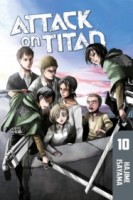 Attack on Titan, Volume 10 by Hajime Isayama. I’m not entirely sure how Isayama pulls it off, but it’s rather impressive how many twists and turns Attack on Titan has been taking lately. I went into this volume expecting a respite from major plot reveals since there have been so many recently. I was wrong. The focus of the tenth volume is on 104th’s struggle to survive against a massive titan attack on the castle in which they were hoping to hide and recover. They are without weapons or maneuvering gear, making their situation particularly precarious. This alone would have been enough to carry the volume and there are some very exciting moments in the fight. But no. After an extended action sequence, Isayama throws in not one but two (well, maybe three depending on how you’re counting) major story twists. Although there are still plenty of questions that need to be answered, the titans themselves are becoming less of a mystery. I actually kind of miss when they were beyond humanity’s comprehension, but I’m still interested in seeing how things play out.
Attack on Titan, Volume 10 by Hajime Isayama. I’m not entirely sure how Isayama pulls it off, but it’s rather impressive how many twists and turns Attack on Titan has been taking lately. I went into this volume expecting a respite from major plot reveals since there have been so many recently. I was wrong. The focus of the tenth volume is on 104th’s struggle to survive against a massive titan attack on the castle in which they were hoping to hide and recover. They are without weapons or maneuvering gear, making their situation particularly precarious. This alone would have been enough to carry the volume and there are some very exciting moments in the fight. But no. After an extended action sequence, Isayama throws in not one but two (well, maybe three depending on how you’re counting) major story twists. Although there are still plenty of questions that need to be answered, the titans themselves are becoming less of a mystery. I actually kind of miss when they were beyond humanity’s comprehension, but I’m still interested in seeing how things play out.
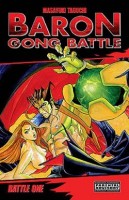 Baron Gong Battle, Volumes 1-6 by Masayuki Taguchi. Only six out of the nine volumes of Baron Gong Battle have been released in English. After his girlfriend is horrifically murdered by a Neo Hume, Baron is determined to seek revenge against those who killed her. The Neo Hume’s are extraordinarily powerful creatures born out of the Nazi’s biological experiments. Baron Gong Battle is an utterly absurd and violent action-packed manga series that can be a tremendous amount of trashy fun when it’s not being completely offensive. Baron is an over-the-top badass and the dialogue is extreme. However, the more that I read, the less enamored I became with Baron Gong Battle. The manga’s utter ridiculousness is highly entertaining, and it becomes more and more outrageous as the series progresses, but I soon became tired of the role that the women play. Occasionally they can be very competent fighters, but more often than not they seem to only be a part of the series in order to fawn over Baron and to run around mostly if not entirely naked.
Baron Gong Battle, Volumes 1-6 by Masayuki Taguchi. Only six out of the nine volumes of Baron Gong Battle have been released in English. After his girlfriend is horrifically murdered by a Neo Hume, Baron is determined to seek revenge against those who killed her. The Neo Hume’s are extraordinarily powerful creatures born out of the Nazi’s biological experiments. Baron Gong Battle is an utterly absurd and violent action-packed manga series that can be a tremendous amount of trashy fun when it’s not being completely offensive. Baron is an over-the-top badass and the dialogue is extreme. However, the more that I read, the less enamored I became with Baron Gong Battle. The manga’s utter ridiculousness is highly entertaining, and it becomes more and more outrageous as the series progresses, but I soon became tired of the role that the women play. Occasionally they can be very competent fighters, but more often than not they seem to only be a part of the series in order to fawn over Baron and to run around mostly if not entirely naked.
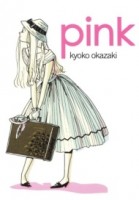 Pink by Kyoko Okazaki. While I didn’t find Pink to be as brutal or as hard-hitting as Okazaki’s later work Helter Skelter, I still think that the manga is an excellent work and I enjoyed it a great deal. Pink is rather curious manga filled with rather curious characters. In general, they are much more likeable than those in Helter Skelter, but they are definitely an odd bunch. Yumi works as a part-time call girl in order to feed her pet crocodile Croc. Although Yumi’s on great terms with her younger stepsister Keiko–a precocious girl with a bottomless stomach–she and her stepmother hate each other. Things get a little complicated when Yumi becomes involved with Haruo, her stepmother’s manstress and wannabe novelist. I was actually surprised by how much of the Pink was told from Haruo’s perspective. His strange relationships with these three women, and Croc, forms the basis for much of the story. But even so, it’s Yumi who really seems to be the focus of the manga. Pink has a very cynical and oddball sense of humor which I could appreciate.
Pink by Kyoko Okazaki. While I didn’t find Pink to be as brutal or as hard-hitting as Okazaki’s later work Helter Skelter, I still think that the manga is an excellent work and I enjoyed it a great deal. Pink is rather curious manga filled with rather curious characters. In general, they are much more likeable than those in Helter Skelter, but they are definitely an odd bunch. Yumi works as a part-time call girl in order to feed her pet crocodile Croc. Although Yumi’s on great terms with her younger stepsister Keiko–a precocious girl with a bottomless stomach–she and her stepmother hate each other. Things get a little complicated when Yumi becomes involved with Haruo, her stepmother’s manstress and wannabe novelist. I was actually surprised by how much of the Pink was told from Haruo’s perspective. His strange relationships with these three women, and Croc, forms the basis for much of the story. But even so, it’s Yumi who really seems to be the focus of the manga. Pink has a very cynical and oddball sense of humor which I could appreciate.
 From the New World directed by Masashi Ishihama. Overall I really liked the story and setting of the From the New World anime, an adaptation of the novel by the same name written by Yusuke Kishi (which sadly has yet to be licensed in English.) However, I frequently found the series’ pacing and narrative structure to be frustrating and somewhat disjointed. Saki, the main protagonist, also had an annoying habit of echoing back whatever was being said to her by someone else. I did like that the story focused on the characters at several different points in their lives. From the New World takes place in what is eventually revealed to be a post-apocalyptic environment. I actually would have liked to have seen more about how society reached the point that it is at in the series; most of the past events are merely hinted at. From the New World deals quite a bit with the terrible lengths humanity is willing to go to when driven by fear. It’s very well done in places. The anime also gets bonus points for the nice use of music from Dvořák’s From the New World symphony.
From the New World directed by Masashi Ishihama. Overall I really liked the story and setting of the From the New World anime, an adaptation of the novel by the same name written by Yusuke Kishi (which sadly has yet to be licensed in English.) However, I frequently found the series’ pacing and narrative structure to be frustrating and somewhat disjointed. Saki, the main protagonist, also had an annoying habit of echoing back whatever was being said to her by someone else. I did like that the story focused on the characters at several different points in their lives. From the New World takes place in what is eventually revealed to be a post-apocalyptic environment. I actually would have liked to have seen more about how society reached the point that it is at in the series; most of the past events are merely hinted at. From the New World deals quite a bit with the terrible lengths humanity is willing to go to when driven by fear. It’s very well done in places. The anime also gets bonus points for the nice use of music from Dvořák’s From the New World symphony.
